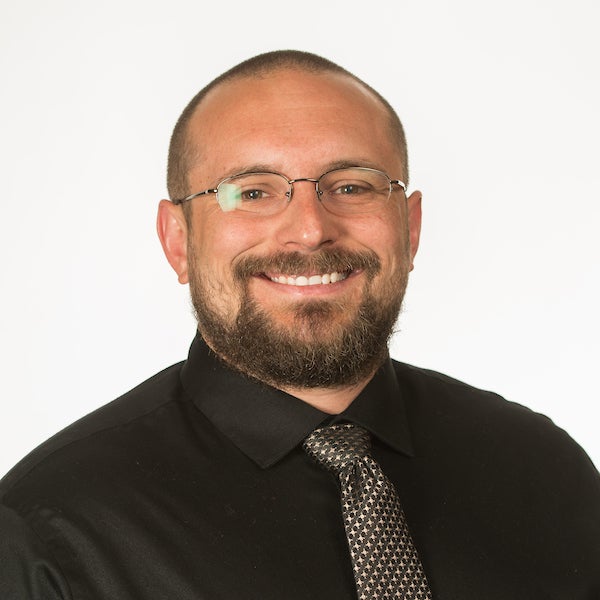Army veteran unlocks secrets of photosynthesis as ASU graduate

Christopher Gisriel (center) with his PHD adviser Kevin Redding (right), professor of chemistry and biochemistry in the School of Molecular Sciences at ASU; and Raimund Fromme, associate research professor in the School of Molecular Sciences.
Editor’s note: This is part of a series of profiles for fall 2017 commencement. See more graduates here.
Army veteran Christopher Gisriel, who graduated with a bachelor’s degree in 2013 and is now graduating with a doctorate in biochemistry from Arizona State University's School of Molecular Sciences, really excels in research.
After graduating from high school in northern Virginia (though Baltimore is his hometown), Gisriel was urged by his parents to join a military service. Both his father and grandfather are U.S. Army veterans, so he decided to follow in their footsteps. He enlisted in an infantry regiment of the Virginia Army National Guard. Shortly after basic and advanced individual training, Chris was deployed to Bagram, Afghanistan, from 2004 to 2005 where he performed both logistical and infantry duties.
Gisriel returned home and moved to Phoenix, where he spent two semesters in community college studying chemistry and biology. Shortly thereafter he transferred to ASU. He declared biochemistry as his major and contacted some labs in the hope of performing research to give his studies a more practical application.
“Professor Kevin Redding replied, and I met him for a tour of his lab,” Gisriel said. “It is funny looking back, but I remember being impressed by the fact that they froze microorganisms in liquid nitrogen for storage. Kevin explained his lab’s research ambitions: to use biochemical and biophysical techniques to understand how certain proteins involved in photosynthesis really work. He offered me an undergraduate research position, and I immediately jumped at the opportunity.”

Christopher Gisriel
“Chris is a veteran of the U.S. Army, having served in Afghanistan,” Redding said. “He came to ASU as a biochemistry major and started working in my lab as an undergraduate researcher. Having never seriously considered the possibility of a career in research before, he was unsure at first how far he wanted to go down this path. However, he soon developed a taste for it, and then pushed me to allow him to take on the reaction center (RC) crystallography project as a master’s student. I cautioned him against it, knowing how hard it would be and how low the chances of success, but he persisted. He later decided to pursue a doctorate and now, as we published in Science recently, seems to have succeeded. He defended his dissertation last month, and I could not be prouder of him.”
“This reaction center is only found in organisms that can live in oxygen-free environments, like that of early Earth,” Gisriel said. "This work has opened the door for scientists all over the world to compare the primitive reaction center's characteristics with those of more advanced reaction centers that reside in oxygen-tolerant organisms. As a result, we are gaining a more clear and informed picture of how nature optimized light-driven energy collection.”
Question: What was your “aha” moment, when you realized you wanted to study the field you majored in?
Answer: I took classes from Neal Woodbury and Jim Allen during my undergraduate work. Frankly, they seemed to have such a profound understanding of biochemistry that I wanted to have the same interests they had. Both had huge contributions to the field of photosynthesis research, so I began there!
Q: What’s something you learned while at ASU — in the classroom or otherwise — that surprised you, that changed your perspective?
A: I learned that true education has nothing to do with grades. It has to do with the collaborative efforts of individuals who explore the finest details of a topic, and who can appropriately articulate their findings to others.
Q: Why did you choose ASU?
A: A professor who taught at both the community college I had attended and ASU commented that ASU was an incredible place for research. This was a large contributing factor in my desire to be involved in said research.
Q: What’s the best piece of advice you’d give to those still in school?
A: If you can find the courage to disregard others’ expectations of your educational success, you are far more likely to discover what will make you an exceptional student.
Q: What was your favorite spot on campus, whether for studying, meeting friends or just thinking about life?
A: My favorite place on campus is my lab. For me, it has been a place of much frustration, comedy and scientific success.
Q: What are your plans after graduation?
A: I will start a post-doctoral research position in January at ASU working with Petra Fromme’s group.
Q: If someone gave you $40 million to solve one problem on our planet, what would you tackle?
A: I would invest in new ways of making sustainable energy more efficient. Currently, world reliance upon fossil fuels not only has negative impacts on the environment, but also creates an unequal distribution of wealth.
More Science and technology

4 ASU researchers named senior members of the National Academy of Inventors
The National Academy of Inventors recently named four Arizona State University researchers as senior members to the prestigious…

Transforming Arizona’s highways for a smoother drive
Imagine you’re driving down a smooth stretch of road. Your tires have firm traction. There are no potholes you need to swerve to…

The Sun Devil who revolutionized kitty litter
If you have a cat, there’s a good chance you’re benefiting from the work of an Arizona State University alumna. In honor of…

